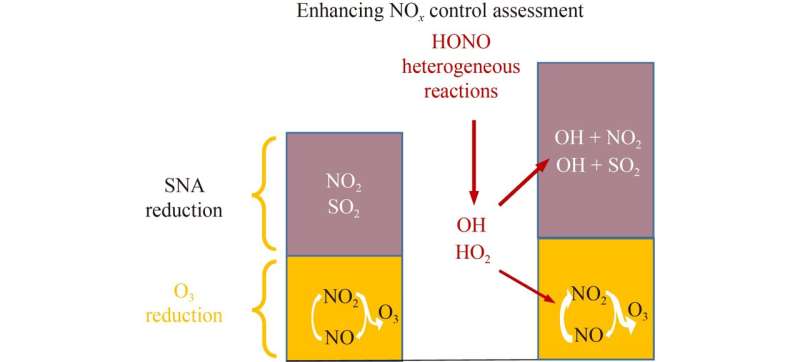This article has been reviewed according to Science X's editorial process and policies. Editors have highlighted the following attributes while ensuring the content's credibility:
fact-checked
proofread
Study explores the connection between nitrogen oxides control and SNA, ozone reduction

Sulfate-nitrate-ammonium (SNA) and other atmospheric aerosols play a significant role in influencing both atmospheric and environmental conditions. These aerosols impact climate directly through scattering and absorbing solar radiation, thus influencing the Earth's radiative balance.
The presence of high concentrations of aerosols can lead to the formation of haze and reduce air quality, affecting human health and transportation. Furthermore, the fine particulate matter (PM2.5 and PM10) within aerosols poses health risks as it can be inhaled into the respiratory system, leading to respiratory and cardiovascular diseases.
On the other hand, ozone (O3), a triatomic molecule, exerts diverse impacts on the environment and the atmosphere. In the lower atmosphere, ground-level ozone serves as a prominent air pollutant, forming a key component of photochemical smog through chemical reactions with nitrogen oxides (NOx) and volatile organic compounds (VOCs) in the presence of sunlight. This ozone poses health risks, adversely affecting the respiratory system and human well-being. Additionally, elevated concentrations of ozone have detrimental effects on ecosystems and food chains.
A recent study by Prof. Biwu Chu and Prof. Jia Xing's research team has highlighted how controlling NOx emissions is a potent measure for protecting the environment, especially when it comes to lowering levels of harmful particles (SNA) and ground-level ozone (O3).
Additionally, the researchers conducted a series of simulation experiments in China to discern the specific advantages of NOx control with and without the inclusion of heterogeneous nitrous acid (HONO) formation. By incorporating heterogeneous HONO chemistry into their model, they successfully showed the impact of HONO on NOx reduction, resulting in notable benefits for controlling the SNA and O3 levels.
Their work is published in the journal Frontiers of Environmental Science & Engineering.
We should continue to explore methods of controlling atmospheric pollution and reducing SNA and O3. Undoubtedly, the research conducted by Prof. Chu and Prof. Xing has provided us with a new perspective, bringing us one step closer to a cleaner atmospheric environment and a safer living space.
The other contributors include scholars from Tsinghua University (Beijing, China), Chinese Academy of Sciences (Beijing, China), Yellow River Institute of Hydraulic Research (Zhengzhou, China), and Center for Climate Research (Singapore).
More information: Shuping Zhang et al, Underestimated benefits of NOx control in reducing SNA and O3 based on missing heterogeneous HONO sources, Frontiers of Environmental Science & Engineering (2023). DOI: 10.1007/s11783-024-1790-y
Provided by Higher Education Press





















